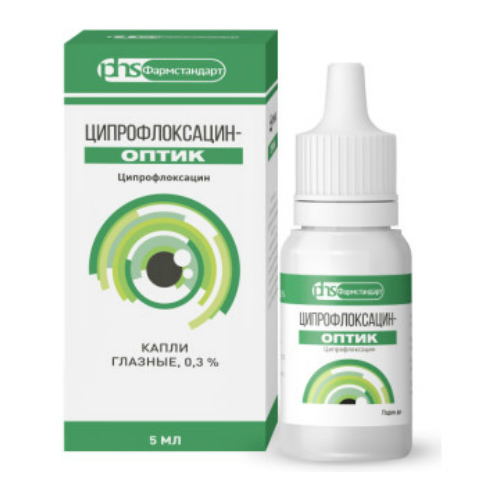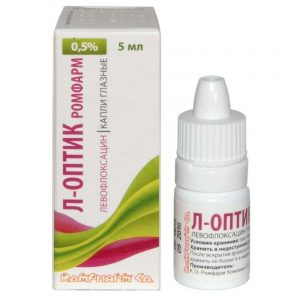Description
Pharmacological action of
Pharmacotherapeutic group: Antimicrobial agent – fluoroquinolone
ATX:
J.01.MA02 Ciprofloxacin
Pharmacodynamics: Antimicrobial agent with a broad spectrum of activity, a derivative of the superficial quinolizirazone II, fluoroquinisomezone, chromosomal DNA around nuclear RNA, which is necessary for reading genetic information) disrupts DNA synthesis, the growth and division of bacteria causes pronounced morphological changes (including including cell wall and membranes) and the rapid death of a bacterial cell.
It acts bactericidal on gram-negative organisms during dormancy and division (since it affects not only DNA gyrase, but also causes lysis of the cell wall), on gram-positive microorganisms – only during the period of division.
Low toxicity to macroorganism cells is explained by the absence of DNA gyrase in them. While taking ciprofloxacin, there is no parallel development of resistance to other antibiotics that do not belong to the group of gyrase inhibitors, which makes it highly effective against bacteria that are resistant, for example, to aminoglycosides, penicillins, cephalosporins, tetracyclines and many other antibiotics.
Gram-negative aerobic bacteria are susceptible to ciprofloxacin: enterobacteria (Escherichia coli, Salmonella spp., Shigella spp., Citrobacter spp., Klebsiella spp., Enterobacter spp., Proteus mirabilis, Proteus vulgaris, Serratia rappenissa marciensiens, ., Morganella morganii, Vibrio spp., Yersinia spp.), Other gram-negative bacteria (Haemophilus spp., Pseudomonas aeruginosa, Moraxella catarrhalis, Aeromonas spp., Pasteurella multocida, Plesiomonas shigeoides, some Campylobacter jejuni, leppella leppella leppella leppella leppella leppella lepperia , Chlamydia trachomatis, Listeria monocytogenes, Mycobacterium tuberculosis, Mycobacterium kansasii, Corynebacterium diphtheria) Gram-positive aerobic bacteria: Staphylococcus spp. (Staphylococcus aureus, Staphylococcus haemolyticus, Staphylococcus hominis, Staphylococcus saprophyticus), Streptococcus spp. (Streptococcus pyogenes, Streptococcus agalactiae).
Most methicillin-resistant staphylococci are also resistant to ciprofloxacin.
Sensitivity Streptococcus pneumoniae, Enterococcus faecalis, Mycobacterium avium (located intracellularly) is moderate (high concentrations are required to suppress them).
Resistant to the drug: Bacteroides fragilis, Pseudomonas cepacia, Pseudomonas maltophilia, Ureaplasma urealyticum, Clostridium difficile, Nocardia asteroides.
Ineffective against Treponema pallidum.
Resistance develops extremely slowly, because, on the one hand, after the action of ciprofloxacin, there are practically no persistent microorganisms, and on the other hand, bacterial cells have no enzymes that inactivate it.
Mechanisms for the development of resistance
The development of resistance to fluoroquinolones, in particular ciprofloxacin, is mediated by changes in genes encoding at least one of 4 mechanisms: 1. a change in the structure of target enzymes (DNA gyrase and topoisomerase IV) – enzymes, involved in the synthesis of
cell DNA 2. impaired permeability of the cell wall
3. active removal of the drug from the cell (increased activity of efflux pumps)
4. plasmid-mediated changes in the functioning of aminoglycoside 6-N-acetyltransferase.
Pharmacokinetics: Absorption of
It is rapidly absorbed when applied topically.
Distribution of
Plasma concentration of ciprofloxacin after instillation in the conjunctiva of 2 drops of a 0.3% solution every 2 hours for 2 days, and then every 4 hours for 5 days ranged from non-quantifiable (<1.0 ng / ml ) up to 4.7 ng / ml. The average maximum plasma concentration of ciprofloxacin obtained in this study is approximately 450 times less than after oral administration of ciprofloxacin at a dose of 250 mg. Ciprofloxacin is widely distributed in body tissues, approximately the volume of distribution is from 1.7 to 5 l / kg. Communication with blood plasma proteins is 20-40%. Metabolism No information is available on the metabolic pathways of ciprofloxacin. Excretion The elimination half-life from plasma is 3-5 hours. Ciprofloxacin and its four metabolites are excreted in urine and feces. About 2/3 of the total level of ciprofloxacin in plasma is eliminated through the kidneys, while 1/3 of the total level of ciprofloxacin is secreted through the intestines and with bile. In patients with impaired renal function, there is a slight increase in the half-life of ciprofloxacin due to extrarenal elimination pathways. Similarly, with impaired liver function, the elimination half-life is slightly longer. There is no evidence of a study of the pharmacokinetic properties of ciprofloxacin when used in children. Indications Treatment of corneal ulcers and infections of the anterior segment of the eyeball and its appendages, caused by bacteria sensitive to ciprofloxacin in adults, newborns (from 0 to 27 days), infants and infants (from 28 to 23 months), children (from 2 to 11 years) and adolescents (from 12 to 18 years). Contraindications Hypersensitivity to the active substance and any of the excipients. Hypersensitivity to quinolones. Caution: The drug should be prescribed with caution to patients with cerebral arteriosclerosis, cerebrovascular accident, convulsive syndrome due to the threat of adverse reactions from the central nervous system. Use during pregnancy and lactation Fertility When conducting studies of oral dosage forms of ciprofloxacin in animals, no negative effect on fertility was detected. No studies have been conducted to evaluate the effect of ciprofloxacin in the form of instillations on human fertility. Pregnancy There are no data on the use of ciprofloxacin in the dosage form eye drops in pregnant women. In animal studies, no results have been obtained indicating a negative effect of ciprofloxacin on reproductive function. It is expected that systemic levels of ciprofloxacin when used in a dosage form, eye drops will be low. Given the lack of safety data for pregnancy, it is recommended that ciprofloxacin be given during pregnancy only in cases where the anticipated benefits of the drug from the mother outweigh the potential risk to the fetus. Breastfeeding period With oral administration of ciprofloxacin by women during breastfeeding, it is excreted into breast milk. Unknown whether ciprofloxacin is excreted in breast milk when used in the form of instillations, however, the risk for a breast-fed baby cannot be excluded in this case. Caution should be exercised when using the drug for women during breastfeeding. Special instructions The solution in the form of eye drops is not intended for intraocular injection. When using other ophthalmic medicines, the interval between their administration should be at least 5 minutes. Use of the drug should be discontinued if any signs of hypersensitivity appear. The patient should be informed that if, after applying the drops, conjunctival hyperemia continues or increases for a long time, stop using the drug and consult a doctor. Wearing soft contact lenses is not recommended during treatment with the drug. When using hard contact lenses, they should be removed before instillation and put on again 15-20 minutes after instillation of the drug. Impact on the ability to drive transp. Wed and fur.: After applying eye drops, it is possible to reduce the clarity of visual perception, therefore, immediately after instillation, it is not recommended to drive a car and engage in activities that require increased attention and speed of psychomotor reactions. Composition Per 1 ml: Active ingredient: ciprofloxacin hydrochloride – 3.49 mg, in terms of ciprofloxacin – 3.0 mg Excipients: disodium edetate dihydrate (trilon B) – 0.4 mg, sodium mg, benzalkonium chloride – 0.2 mg, sodium hydroxide solution 1 M – up to pH 3.5-5.5, purified water – up to 1.0 ml Dosage and Administration Ciprofloxacin is applied topically. Do not administer subconjunctival or into the anterior chamber of the eye. In case of corneal ulcers, the drug must be instilled, observing the following intervals between instillations (including at night): on the first day – 2 drops every 15 minutes for the first 6 hours, then 2 drops every 30 minutes for the remaining time of the day. On the second day of therapy – 2 drops every hour. From the third to the 14th day of therapy – 2 drops every 4 hours. If it is necessary to continue therapy for more than 14 days, the dosage regimen should be selected by the attending physician. For diseases of the anterior segment of the eyeball, the drug should be instilled as follows: 1 or 2 drops into the affected eye (s) 4 times a day. In severe infections, the dosage regimen in the first 2 days may include instillation of the drug in 1 or 2 drops every 2 hours during wakefulness. The duration of therapy with the drug according to the stated indications should not exceed 21 days. Application in the pediatric population The dosing regimen during therapy in children over the age of 1 year corresponds to that in adults. The efficacy and safety of ciprofloxacin in children aged 0 to 12 years has been confirmed in clinical studies involving 230 children. No serious adverse events were noted in this group of patients. Use in renal and hepatic insufficiency There is no information on the use of ciprofloxacin in patients with concomitant diseases of the liver and kidneys. When using the drug to reduce the risk of developing systemic adverse reactions, it is recommended to lightly press a finger on the inner corner of the eye in the projection of the lacrimal sac for 1-2 minutes after instillation of the drug. Side effects of In clinical trials, such adverse events were most often observed as discomfort in the eye (in 6% of cases), dysgeusia (in 3% of cases) and precipitates on the cornea (in 3% of cases). Adverse reactions from clinical trials and post-marketing observation, grouped according to the following gradation of the frequency of occurrence: very often (? 1/10), often (from? 1/100 to <1/10), infrequently (from? 1/1000 to <1/100), rarely (from? 1/10000 to <1/1000), very rarely (<1/10000), with an unknown frequency (the frequency of occurrence cannot be established based on available information). In each of the groups, the enumeration of reactions is carried out as their occurrence decreases. Organ system Adverse events Immune system disorders Rarely: hypersensitivity reactions. Disorders of the nervous system Infrequently: headache. Rarely: dizziness. Visual disturbances Often: precipitates on the cornea, eye discomfort, conjunctival injection. Infrequently: keratopathy, spot keratitis, corneal infiltrates, photophobia, decreased visual acuity, eyelid edema, blurred vision, eye pain, dry eye, conjunctival and eyelid edema, lacrimation, discharge from the eyes, formation of crusts on the edges of the eyelids, peeling of the eyelid skin, hyperemia of the eyelids. Rarely: toxic effects from the organ of vision, keratitis, conjunctivitis, corneal epithelial defect, diplopia, decreased sensitivity of the cornea, asthenopia, barley. Disorders of the organ of hearing and the labyrinth Rarely: pain in the ear. Disorders of the respiratory, chest and mediastinal organs Rarely: increased secretion of the mucous membrane of the paranasal sinuses, rhinitis. Disorders of the digestive system Often: dysgeusia. Infrequently: nausea. Rarely: abdominal pain, diarrhea. Disorders of the skin and subcutaneous fat Rarely: dermatitis. Disturbances from the musculoskeletal system and connective tissue With an unknown frequency: disturbances from the ligamentous apparatus. Description of specific groups of adverse reactions Rare cases of the development of a generalized rash, toxic epidermolysis, exfoliative dermatitis, Stevens-Johnson syndrome and urticaria have been reported. Serious anaphylactic reactions, in rare cases with a fatal outcome, including after taking the first dose, were observed in patients who received oral fluoroquinolones. Some of these reactions were accompanied by cardiovascular collapse, loss of consciousness, swelling of the larynx and face, tingling sensation, dyspnea, itching, and hives. In patients taking fluoroquinolones orally, there were ruptures of tendons of the shoulder joint, tendons of the joints of the hands, Achilles tendon and other tendons, which subsequently required surgical intervention or led to prolonged disability. During clinical studies and post-marketing surveillance, the effect of ciprofloxacin instillations on the state of the musculoskeletal system and connective tissue was not observed. In some cases, instillations of ciprofloxacin resulted in blurred vision, decreased visual acuity and a residual amount of the drug on the surface of the cornea. In the course of systemic use of quinolones, moderate and severe phototoxicity reactions were observed, however, such reactions are not typical for ciprofloxacin. Profile of adverse reactions in the pediatric population The efficacy and safety of ciprofloxacin in children aged 0 to 12 years has been confirmed in clinical studies involving 230 children. No serious adverse events were noted in this group of patients. Drug Interactions No specific drug interaction studies have been conducted with ciprofloxacin. Given the low systemic plasma concentration of ciprofloxacin after instillation into the conjunctival cavity, interactions between ciprofloxacin co-administered drugs are unlikely. In the case of joint use with other local ophthalmic preparations, the interval between their use should be at least 5 minutes, while eye ointments should be used last. Ciprofloxacin-Optic Solution is incompatible with drug solutions having pH values of 3-4 that are physically or chemically unstable. Overdosing In the case of overdose when applied topically in the form of instillations necessary conjunctival cavity rinsed with lukewarm water. The development of toxic effects is not expected both with local overdose and with accidental ingestion of the contents of the vial. Storage conditions At a temperature not exceeding 25 ° C. Keep out of the reach of children. Expiration 3 years. Pharmacy terms of sale Prescription Form of Treatment rims glazn e




